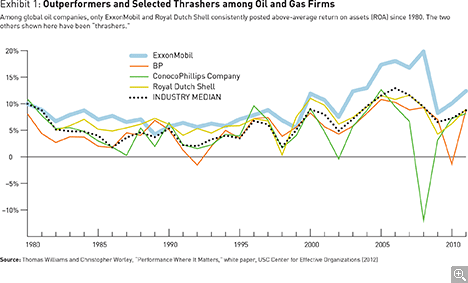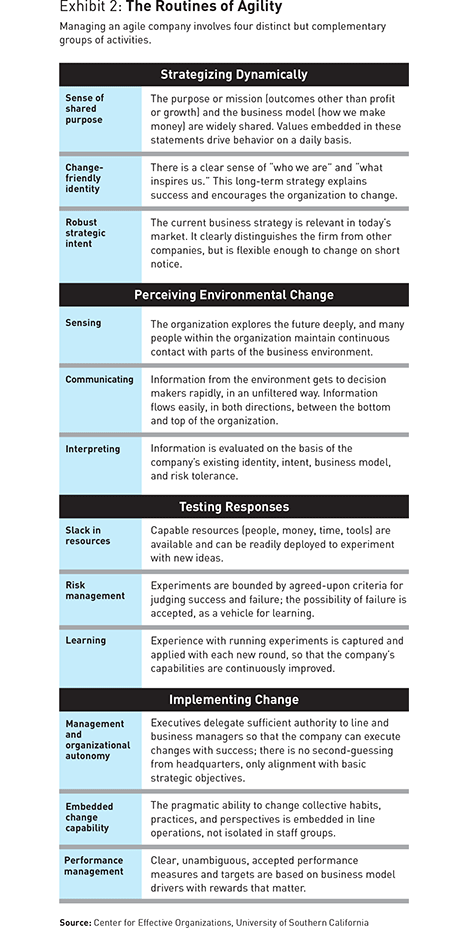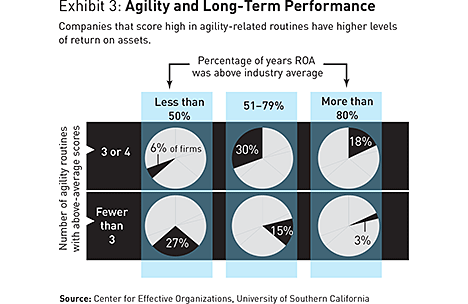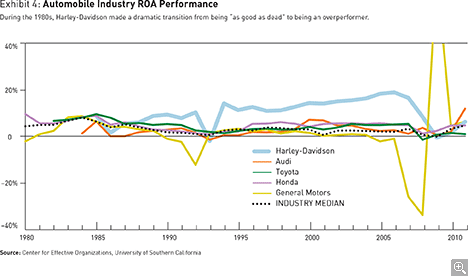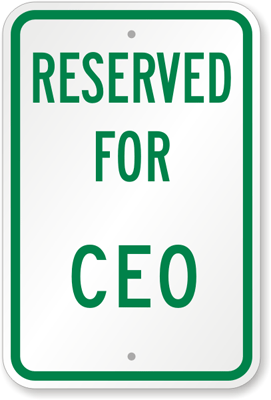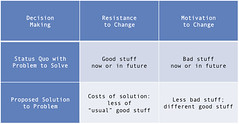A few large companies in every industry show consistently superior profitability relative to their peers, and they all have one thing in common: a highly developed capacity to adapt their business to change.
strategy+business magazine:
Everybody knows that big corporations, by nature, maneuver like battleships. Held back by their own inertia and current business strategies, they cannot turn quickly when the competitive environment changes. Everybody also knows that high performance, as measured by shareholder returns, is impossible to sustain over the long term; no company consistently beats the market.
But a recent in-depth study of long-term performance suggests an alternative point of view about business strategy. When the measure of performance is profitability, a few large companies in every industry consistently outperform their peers over extended periods. And they maintain this performance edge even in the face of significant business change in their competitive environments. The one factor they seem to have in common is agility. They adapt to business change more quickly and reliably than their competitors; they have found a way to turn as quickly as speedboats when necessary.
ExxonMobil is a good example. Throughout the 1980s, when it was still just Exxon, it was the largest, most profitable oil and gas company in the world. ...
T
hen in 1989, Exxon fell from grace. ... When Lee Raymond took over from Lawrence Rawl as chairman in April 1993, Exxon had dropped on Fortune’s list of most admired companies from number six to 110. As Raymond noted in a rare interview, a good day for him was one in which “Exxon” or his name did not appear in the papers.
 |
| Portrait of Lee Raymond (Photo credit: Wikipedia) |
Many companies would have reacted by putting in place short-term fixes and doing whatever they could to return to their old ways of operating. Instead, Exxon quietly moved to internalize the lessons of the Valdez spill and to build the capabilities required for future profitability. ... Recognizing that external upheavals could occur at any time, the company relentlessly drove for efficiency over the 1990s—a fortunate move because oil prices continued to fall throughout the decade. Exxon ... improved its exploration capability (where it had historically lagged behind its competitors), and pushed production efficiency even harder. Through all these measures, and by taking full advantage of the innate discipline for which it was known, Exxon halved its cost of finding oil and greatly improved its exploration success rate. In 1995, Lee Raymond was able to say, “Exxon is now much more efficient at getting on with it.”
Exxon’s focus on execution, technical excellence, and capital efficiency positioned the firm well to exploit the rise in oil prices that began in 1998. In 1999, Raymond, dubbed by Businessweek as the “anti-celebrity CEO,” engineered the largest acquisition in history to that point, and one of the most successful, with Exxon’s purchase of Mobil. In 2000, the combined company became the most profitable in history, a ranking it still holds today, and launched a new series of exploration initiatives to spur growth in oil and gas reserves.
The pattern of adaptation Exxon exhibited is not typical of most large companies. It represents an unusual ability to successfully respond to and learn from external events, to innovate technically and organizationally, and to plan and execute new courses of action. In short, Exxon demonstrated a rare and distinctive ability to continually and successfully adapt to changing circumstances. We call this “agility.” Today, when every industry faces turbulent change as a matter of course, a company’s agility becomes the difference between sustaining performance and falling behind.
Agility and Performance
A closer look at the record of Exxon and other large, public companies, from a variety of industries, supports this link between agility and consistent high performance. We studied the financial performance of 243 large firms in 17 industries over the 30-year period from 1979 to 2009.
Like others before us, we concluded that stock prices and shareholder returns cannot tell a story about sustained performance. ... Exxon and ExxonMobil stock languished through the 1990s, for instance, despite exemplary performance during the dot-com craze.
Thus, instead of relying on total shareholder return (TSR) or its even more misleading cousin, cumulative shareholder return, we looked at return on assets (ROA)—a meaningful proxy for profitability in many companies and a better indicator of management’s effectiveness. (Only one of the 17 industries we studied—financial services and insurance—lacked any kind of reasonable asset base. For this industry, we used return on equity as a more relevant proxy for profitability.) In every industry we studied, there were two or three “outperformers”: companies that achieved above-average industry ROA performance more than 80 percent of the time. Altogether, this group made up 16 percent of the sample. Exxon was a member; between 1979 and 2009, its ROA exceeded the industry average 97 percent of the time.
Among the other companies, we found two common performance patterns. About 18 percent of the sample were “underperformers,” whose profitability was below the industry average 80 percent or more of the time. The remaining 66 percent of the sample were “thrashers”; their profitability oscillated between underperformance and outperformance relative to the industry average.
 |
| Image via CrunchBase |
To complete the link between agility and performance, we surveyed more than 4,700 directors and executives from 56 companies (including outperformers, underperformers, and thrashers), 34 of which were Fortune 500 firms included in the financial database. We asked about the way their organizations formulated strategy, designed their structures and processes, led their people, and changed and innovated. We also interviewed executives at 19 of the Fortune 500 firms.
When we compared our survey and interview data with the performance data, we observed a strong relationship between a company’s basic approach to management and its long-term profitability patterns. When markets and technologies changed rapidly and unpredictably—as they did in every industry over these 30 years—the outperformers had the capability to anticipate and respond to events, solve problems, and implement change better than thrashers. They successfully adapted. They were agile.
What Is Agility?
Agility is ... a cultivated capability that enables an organization to respond in a timely, effective, and sustainable way when changing circumstances require it. The management literature increasingly refers to this ability as a “dynamic capability”: the potential to sense opportunities and threats, solve problems, and change the firm’s resource base. This allows outperformers to maintain or enhance their relative advantages in ways their competitors fail to see or do not fully implement. Agility is also strategically relevant: Although agile organizations often change, they do not pursue change for change’s sake. They pursue it for the sake of competitive advantage.
Four routines, summarized in Exhibit 2, below, distinguish the high-performing organizations from the thrashers and underperformers. These companies have the ability to strategize in dynamic ways; accurately perceive changes in their external environment; test possible responses; and implement changes in products, technology, operations, structures, systems, and capabilities as a whole. Importantly, it is the whole system of routines, not the possession of one or two of them, that confers agility. ...[The] hard work necessary to orchestrate them for consistent high performance is advanced and uncommon. By executing these routines in concert, over and over again, the outperformers consistently outpaced competitors.
Strategizing dynamically. ... [Agile] organizations don’t define strategy the way other firms do. For them, strategy has three explicit parts: a sense of shared purpose, a change-friendly identity that is nonetheless stable enough to ground the organization, and a robust strategic intent that clarifies how the firm differentiates itself.
The Capital One Financial Corporation, ... demonstrates all three elements of strategizing dynamically. It has a widely shared and well-understood sense of purpose that is codified in its mission statement and business model. ...
Capital One’s change-friendly identity is embodied in a phrase that its managers often use in conversation: “test and learn.” ...
The company’s ongoing business strategy—its strategic intent—also enables it to embrace continuous change. Capital One is known for its willingness to rapidly shift its operations (for example, the range of customer segments served, channels used, or products offered); to adjust the aggressiveness of its marketing, customer support, new product development, or R&D; and to modify the features it offers consumers. Capital One seeks its competitive advantage not through a single product line or approach, but through an ongoing series of temporary advantages that exploit current business conditions.
Perceiving environmental change. Agile companies take special care to accurately sense what is going on in the environment. Managers and employees are put into direct contact with customers, regulators, and other stakeholders through multiple touch points, structures, and practices, and they are expected to gather intelligence. They communicate their perceptions of the external world to company decision makers who have the support and knowledge they need to interpret those messages as important or unimportant, opportunity or threat. All three elements of perceiving environmental change are essential. Sensing without communicating is wasteful; communicating without interpreting is just noise.
DaVita HealthCare Partners Inc., a Fortune 500 kidney care organization with more than 1,840 dialysis centers, has an effective, institutionalized perceiving routine. To keep all employees focused on the external environment, DaVita abandoned the organization chart. ... DaVita’s management system orients each local dialysis center to the needs of patients, physicians, and the community. Meanwhile, central management concentrates on activities that deliver future value for the corporation—they charter teams to build leaders, research the implications of healthcare reform, identify M&A prospects, and develop new business. One of these teams identified and pursued a recent merger with HealthCare Partners. This process also identified international dialysis as a potential business opportunity.
This external focus is supported by a hard-and-fast rule that moves information up the hierarchy: “Whenever there is a director and three or more team members in a room, there’s a town hall meeting.” In these meetings, any question can be asked about any subject. If the director doesn’t have an answer, the question goes into his or her email and has to be answered within 48 hours.
All that information—from dialysis centers and initiative teams—gets funneled to top management for consideration. ... At DaVita, different top management teams are accountable for different purposes. That allows the company to assign people with the right expertise to various questions and issues, and improves their ability to interpret signals from their externally focused organization.
Thrashers and underperformers, with inward-looking and politicized management, find this level and intensity of communication congenitally difficult. They are too busy vying for turf, resources, and position to dispassionately consider the implications of outside signals. The external focus of agile companies enables them to face up to brutal facts and separate wheat from chaff.
Testing responses. Agile organizations refine their insights from the perceiving routine with a relatively high number of low-cost experiments. They encourage innovation and tolerate a good deal of failure. ... In most cases, there are explicit risk management processes—with valid success criteria so the plug can be pulled if the test fails—and continuous learning efforts so that the insights gained from the tests spread to all relevant parts of the company. Agile organizations invest significantly in learning and continuous improvement, never resting on their laurels or believing they have “cracked the code” once and for all.
The Limited Brands has both informal and formal testing routines that help the apparel retail chain keep pace with fashion trends and competition. Managers get in the habit of asking one another, “What’s new, what’s next?” This connects everyone in the organization, from senior managers to store merchants, to the observations and data they’ve gathered, ... and pushes them to consider what they are going to do about it. The “what’s new, what’s next” mantra keeps them on their toes. At the store level, small-scale testing procedures make it easy to try out new concepts, point-of-purchase displays, and product extensions. Consumer responses to small-scale tests are vetted by managers, and investment decisions follow successful ideas. Two of the Limited’s blockbuster retail brands—Victoria’s Secret and Bath and Body Works—got started this way. Their success as small experiments inside existing retail stores caught management’s attention and led to big commitments from CEO Les Wexner.
To enable these tests, agile organizations are not always and everywhere “lean and mean.” They must consciously build in extra organizational slack—investing in people, money, and time that don’t go directly to the bottom line, but allow the agile organization to rapidly deploy resources against opportunities that may or may not pay off, without jeopardizing day-to-day operations. The higher staffing levels also play an important role in capturing and disseminating learning that the organization can use later.
Implementing change. Agile companies have mastered the internal program management capabilities they need to convert successful tests and promising innovations into widespread practices. ... These companies have histories of successful transformations, restructurings, and merger integrations, and they also excel at the execution of new product rollouts, policy changes, and compliance mandates, as Exxon demonstrated after the Valdez spill.
The Swedish bank Svenska Handelsbanken is built on the principle of radical decentralization, and its record of financial success is unmatched; the recent financial crisis hardly dented performance. Guided by a change-friendly identity and the slogan “the branch is the bank,” branch managers are responsible for financial results and have the budget authority to take action. They control marketing decisions (except when a new product common to all branches is being launched), staffing levels, salaries, and property lease costs. In addition, on average, half of a branch’s staff has lending authority, permitting customers to receive answers very quickly. Branch managers are held accountable for results and continuous improvement by a “relative performance measurement system” that transparently compares all branches on a quarterly basis. At the end of the year, a performance-based profit-sharing system for all employees is triggered when the organization’s after-tax return on shareholders’ equity (excluding extraordinary items) is higher than the average for other Nordic banks. One-third of the excess amount is placed in an employee fund, and all employees, including the CEO, receive the same profit share.
Executives at Svenska’s headquarters are expected to support the decentralized approach through coaching, instead of through memos, instructions, and directives. If corporate managers disagree with a branch decision, they are expected to raise the issue through a short email or brief phone call, but the final decision ultimately remains with the local manager.
The implementation of change relies on managerial autonomy and shared leadership. ... Once a decision is made, managers charged with implementation are monitored, but not second-guessed. Strong-form performance management systems provide incentives for managers to follow through. Performance targets are objective and unambiguous; positive and negative consequences are real and transparent.
When we correlated the agility routine scores from the survey data with the firm performance results, a clear pattern emerged. Firms with high scores on three or four of the agility routines (strategizing, perceiving, testing, and implementing) are six times (18 percent vs. 3 percent) as likely to be outperformers in their industry. They are also twice as likely (30 percent vs. 15 percent) to have above-average ROAs between 51 and 79 percent of the time. Firms with only one or two of the agility routines, indicating an incomplete system, are much more likely to have below-average ROAs most of the time (see Exhibit 3). Although improving any one of these routines can make an organization more effective, agile companies, according to their own accounts, have at least three of these four traits in large supply.
Making Organizations More Agile
Developing the agile capability is no small feat, but it has been done. IBM, DaVita, and Harley-Davidson have all demonstrated that transformation is possible by committing to a systematic approach and following through. Even within this group, Harley-Davidson (H-D) stands out. It is one of a handful of companies in our sample that made the transition to agility. Its story demonstrates how organizations can build strategizing, perceiving, testing, and implementing routines.
H-D’s performance has been consistently higher than auto industry norms for more than 20 years (see Exhibit 4). Yet in 1980, the company was as good as dead. Its corporate parent at the time, American Machinery and Foundry (AMF), had put Harley-Davidson up for sale and found no takers. Japanese competitors like Honda had not only encroached on America’s last domestic motorcycle brand, but opened up entirely new segments of commuter and recreational users.
In 1981, Vaughn Beals and 12 other executives took Harley-Davidson private, buying it back from AMF. In a desperate bid for survival, they shrank the company by one-third, rapidly implemented Toyota production system techniques to improve product quality and reduce costs, and successfully petitioned the Reagan administration for the “Harley Tariff” on imported motorcycles over 700cc to give them some breathing room. In 1983, they formed the Harley Owners Group (HOG), a stroke of marketing genius that created the largest factory-sponsored club of its kind and enabled direct communications between H-D and its most fervent customers.
When Rich Teerlink took over as CEO in 1987, he inherited a company that had been rescued from the brink through a strong form of “command and control” management. Naturally, there were questions about whether Harley-Davidson could sustain its success without a crisis to compel its employees. But instead of clinging to a top-down management style, Teerlink and his senior management team engineered a further transformation of H-D using a model of shared leadership and accountability, continuous improvement, and investments in learning and development—practices that are all typically linked with agility. The company’s managers and employees were asked to go from a “tell me what you want me to do” style of managing others to a “given where we’re going, I’ll figure out what’s best to do” approach. Said Teerlink at the time, “I believe fundamentally that people should have the opportunity to influence their lives and their workplace.”
Teerlink and his management team took the company through a series of initiatives, including a “joint vision process” involving the top 130 executives. They clarified and codified Harley-Davidson’s identity, synchronized their planning and performance management to it, and set up an integrated, cascading goal-setting process that provided lines of sight from executives to the worker on the floor. Personal and organizational goals were incorporated into appraisals and variable compensation. Leadership and accountability were distributed throughout the organization. Along the way, Teerlink and other senior leaders paid close attention to the four routines of agility:
Strategizing dynamically. Prior to the buyout, H-D’s reputation and style had been rough, oily, and arrogant. Through strategy and organization changes that consistently emphasized the importance of customers, quality, and accountability, a new identity evolved, summarized in the company vision: “We fulfill dreams inspired by the many roads of the world by providing remarkable motorcycles and extraordinary customer experiences. We fuel the passion for freedom in our customers to express their own identity.”
Perceiving environmental change. At H-D, every employee engages with the outside world—particularly with customers. Through HOG, employees (including current CEO Keith Wandell) ride with customers, attend HOG rallies, and participate in sponsored musical and sporting events. The Harley-Davidson Museum in Milwaukee is a shrine that attracts 300,000 visitors each year. There is also constant formal and informal contact with H-D dealer and supplier networks, and an expanded website where customers can interact directly with marketing and product development. To help communicate the ideas that come in, H-D has a shallow hierarchy and little cultural tolerance for gatekeepers and apparatchiks who would impede or filter information flow to executives.
Testing responses. Managers routinely vet the ideas coming from HOG and dealer connections for viability. These ideas include marketing programs, model customizations, new motorcycle models, new engines, new styling, new manufacturing methods, new ways of working with customers, and new markets. H-D also adopted the quality movement practice of “plan–do–check–act,” wherein activities, processes, and decisions are improved on the basis of collected data, and the military practice of “after action reviews,” wherein participants in a campaign meet in intensive sessions to analyze successes and failures.
Implementing change. Harley-Davidson has repeatedly demonstrated its capacity for ongoing change. Since the leveraged buyout, it has implemented operational restructurings, a new product development process, new management processes and personnel practices, and expansion into Europe and Asia. In 2011, for example, the company embarked on an ambitious program to develop a full-blown mass customization capability. H-D reorganized and scaled down its manufacturing footprint, streamlined R&D, marketed a wide variety of customization options through dealers and the Web, and restructured the manufacturing process to a flexible system that can produce any custom version of any bike in any plant on any day. To accomplish this, the company engaged its unionized workforce to dramatically change work rules and move from 62 job classifications to five.
By the time Rich Teerlink retired in 1999, his team had transformed Harley-Davidson from an inward-looking, marginal, command-and-control organization to an agile, dynamic market leader permeated with shared leadership and accountability. Curiosity, experimentation, and direct action are explicitly encouraged and rewarded. But it is a controlled chaos, held together by the centripetal forces of a strong identity and shared values.
The Agility Challenge
Some business environments change faster and more profoundly than others, but it is a given that yours will change. The point of transformation is to adapt, and the point of pursuing agility is to become more adaptable. Executives in agile organizations make explicit, system-wide decisions that promote adaptability over stability and flexibility over inertia. Leaders and employees see the ability to change and adapt as the key to long-term success. They do not fear or avoid change; they embrace it because their ability to manage change well is their primary advantage.
Managing agile organizations means being willing to give up the activities that make you successful today but that won’t be appropriate tomorrow—over and over again. By contrast, thrashers often increase their commitment to successful courses of action but miss important inflection points in the market. BP, for instance, continued to emphasize cost performance over process safety and compliance for years, resulting in disasters like the 2005 Texas City refinery explosion that killed 15 and the 2010 Deepwater Horizon oil rig explosion and spill. Toyota was enamored with being the biggest auto company in the world and ignored important safety issues. Outperformers are not perfect, but they make fewer mistakes and, like Exxon, when they do stumble, they are quick to see the error and have the capabilities to correct it.
Perceiving the value of constant change is only the first step. Translating that perception into productive action requires know-how, processes, infrastructure, and resources. Leaders must commit the organization to a new course of action, mobilize resources, and implement changes. Niccolò Machiavelli’s insight is as relevant today as it was in the 15th century: “Whosoever desires constant success must change his conduct with the times.”
AUTHOR PROFILES:
- Thomas Williams is a senior executive advisor with Booz & Company. Based in Ridgway, Colo., he specializes in strategy, organization, and management systems for energy and industrial companies.
- Christopher G. Worley is a senior research scientist at the Center for Effective Organizations at the University of Southern California in Los Angeles. He is the coauthor, with Edward Lawler, ofManagement Reset: Organizing for Sustainable Effectiveness (Jossey-Bass, 2011).
- Edward E. Lawler III is the director of the Center for Effective Organizations at USC; the coauthor, with Chris Worley, of Management Reset; and the author of Talent: Making People Your Competitive Advantage (Jossey-Bass, 2008).
- Also contributing to this article was Niko Canner, former senior partner of Booz & Company; and s+bcontributing editor Jim O’Toole.
'via Blog this'

